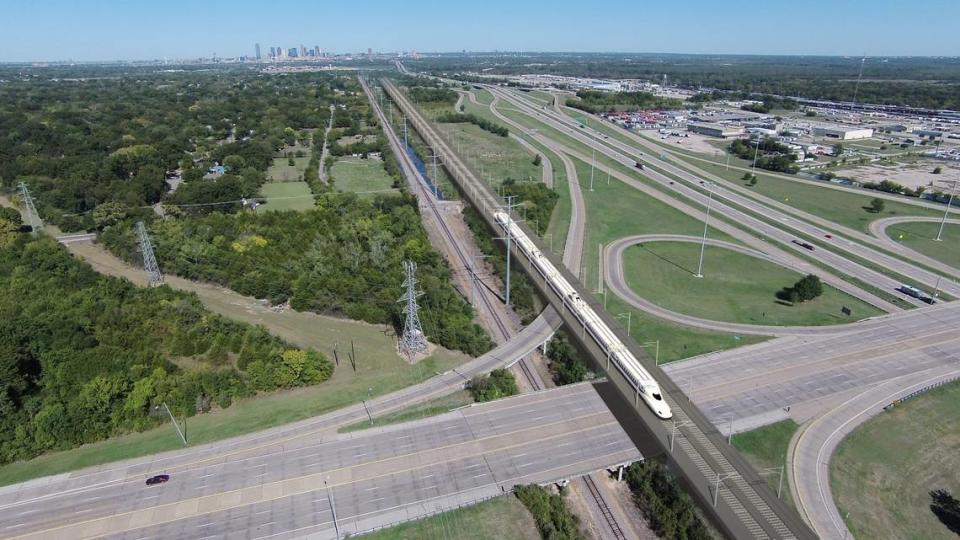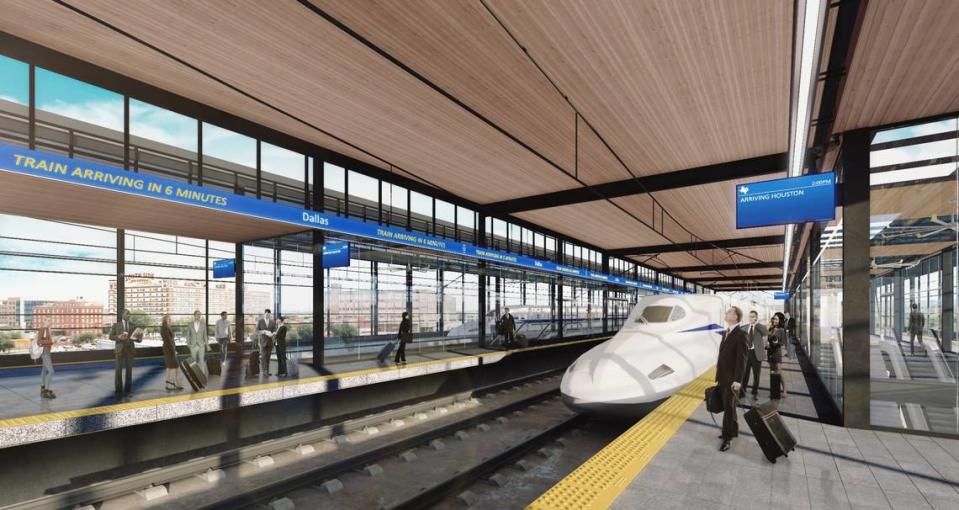Dallas to Houston in less than 90 minutes? What Amtrak’s interest means for bullet train
Supporters are cheering a potential partnership between Texas Central and Amtrak to bring a proposed high speed rail between Houston and Dallas, but opponents remain skeptical about the project and its chances of being finished.
With speeds above 200 mph, the bullet train would make trips between the the cities in less than 90 minutes.
The idea has been in the works for years and got federal approval in 2020 to begin construction. On Wednesday, Texas Central and Amtrak announced they’re “evaluating a potential partnership to further study and potentially advance the project.”
Andy Byford, an Amtrak executive, said in a statement that the corridor offers great potential.
“We believe many of the country’s biggest and fastest-growing metropolitan areas, like Houston and Dallas, deserve more high quality high-speed, intercity rail service and we are proud to bring our experience to evaluate this potential project and explore opportunities with Texas Central so the state can meet its full transportation needs,” Byford said.
The companies have applied for federal grants to study and design the proposed project, according to a news release.
Amtrak and Texas Central say the high-speed rail would reduce trip times for travelers and offer social, environmental, employment and economic benefits for Texans. Opponents have raised a number of concerns about the project, including a lack of transparency, its impact on private property and costs to taxpayers.
A representative from Amtrak was not made available to comment on Thursday. Interview requests sent to Texas Central were not immediately returned.
Texas Central CEO Michael Bui said in a statement that the train has the potential to revolutionize rail travel in the southern United States.
“We appreciate Amtrak’s continued collaboration and look forward to continuing to explore how we can partner in the development of this important project,” Bui said.
What is the planned route?
The route would go between Houston and Dallas with a stop in College Station. There would be three stations, according to Texas Central’s website. In addition, the North Texas Council of Governments is studying a potential high speed rail line between Fort Worth and Dallas.
North Texas Station: In Dallas’ Cedars neighborhood, south of downtown by the Interstate 30 and Interstate 35 interchange.
Brazos Valley Station: In Grimes County on Texas 30. The stations would be about the same distance from College Station and Huntsville, according to Texas Central’s website. There’s also a plan for a shuttle connecting the station to Texas A&M University.
Houston Station: U.S. 290 and Interstate 610 in northwest Houston.
In 2012, project leaders said they expected the rail to be up and running by 2020 and would not seek public funds, according to The Texas Tribune. In August 2022, The Tribune reported that the project had slowed, though a company spokesperson said it was moving forward — land acquisitions had slowed and, according to ENR Texas & Louisana, Texas Central’s board had disbanded and its president and CEO left the company.
That year the Texas Supreme Court ruled Texas Central has eminent domain authority.
Advocates, lawmakers weigh in
Rick Harnish, the executive director of the High Speed Rail Alliance, a Chicago-based advocacy group, called the announcement that Amtrak and Texas Central were working together and seeking potential federal grant dollars a “very big step forward.”
“The value that Texas Central has brought to the table by getting the environmental clearance, by getting additional design work done, has really set the stage for Texas gaining a really huge economic asset,” Harnish said. “And so, it’s really exciting that they’re continuing to work toward achieving that goal.”
In a statement, Dallas and Houston’s mayors expressed support for the project.
“Dallas is the engine of the fourth largest and fastest growing region in the nation,” Dallas Mayor Eric Johnson said. “It is bold, innovative endeavors like this that will propel Dallas toward an even more prosperous future. A high-speed rail line would revolutionize transportation in our region, serve as a catalyst for economic growth, and enhance connectivity among Texas residents and businesses.”
Amtrak and Texas Central estimated that the project could bring thousands of construction jobs, as well as long term jobs for operation and maintenance.
But opponents remain critical of the proposed rail. Waller County Judge Trey Duhon, president of the advocacy group Texans Against High-Speed Rail, raised concerns about the process for developing and vetting the plan, including a lack of transparency from Texas Central.
Jennifer Stevens, a spokesperson for advocacy group ReRoute the Route, worries of potential costs for taxpayers, among other concerns like safety and the route intruding on private property.
“Our position is there’s a way to do this and do it right, but that’s using existing right of way, that’s being honest and transparent about the funding sources that are going to be required from taxpayers, and that’s never happened,” Stevens said.
Rep. Cody Harris, a Palestine Republican who filed a bill during this past legislative session calling for transparency for rail projects, said there are still steps ahead for the project when it comes to federal permitting.
U.S. Rep. Jake Ellzey, a Waxahachie Republican, said in a Wednesday statement, “We are a long way from Congress and the Federal Government authorizing the supposed deal between Amtrak and Texas Central to use eminent domain to take Texans’ property.“ The two lawmakers issued a joint news release opposing the proposed partnership.
“Over the coming weeks, my office will be in contact with Amtrak for a detailed explanation of the status of the high-speed rail project and how they view the execution of this project would impact the folks of my district and all of rural Texas,” Ellzey said.
Harris doubted the project will come to fruition without support from the federal government, the likelihood of which is “very, very small.”
“The only way in my opinion that it ever becomes a reality is if they get the full backing of the federal government and federal loans to complete the project,” he said.


